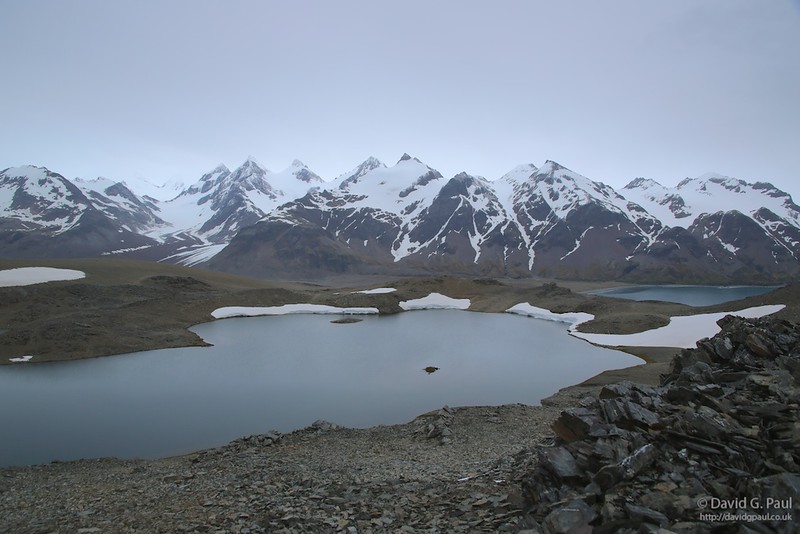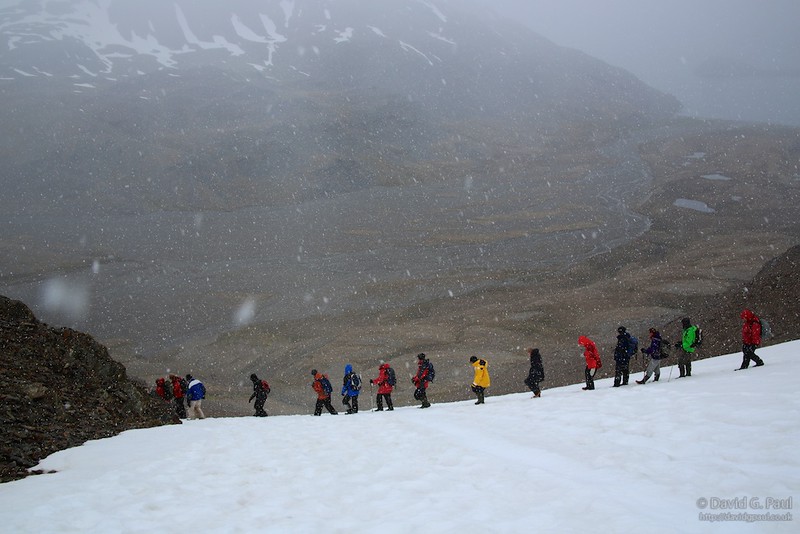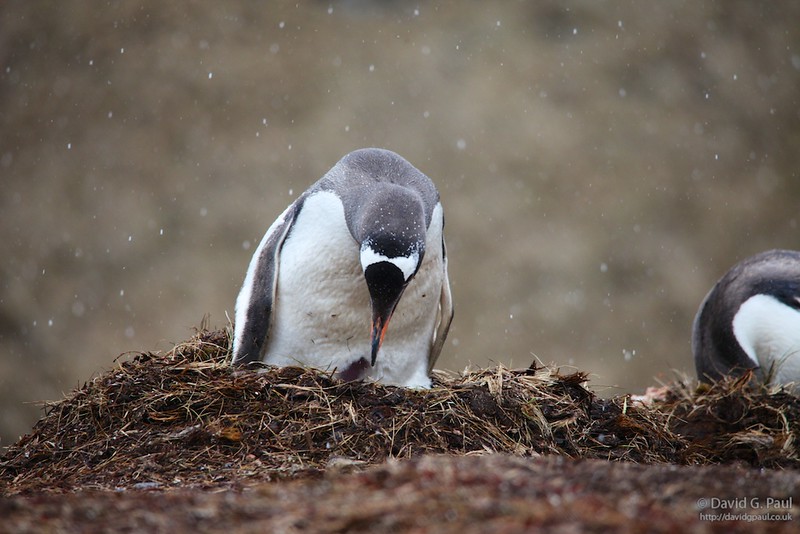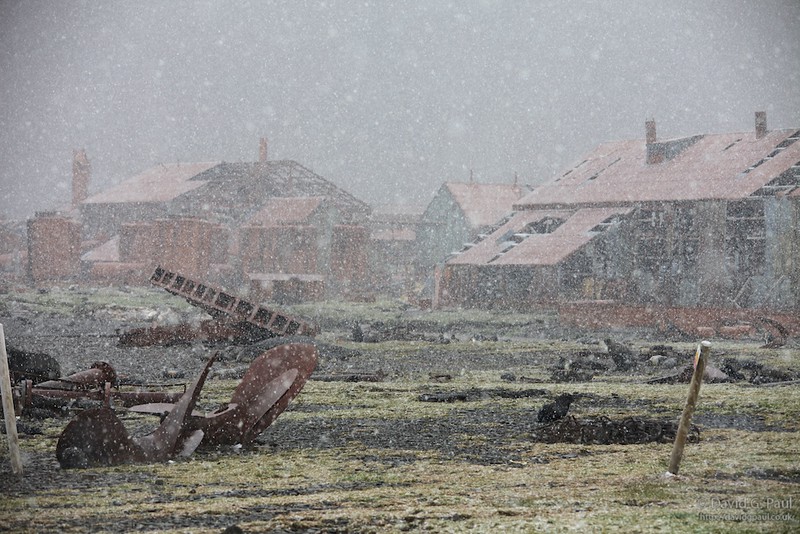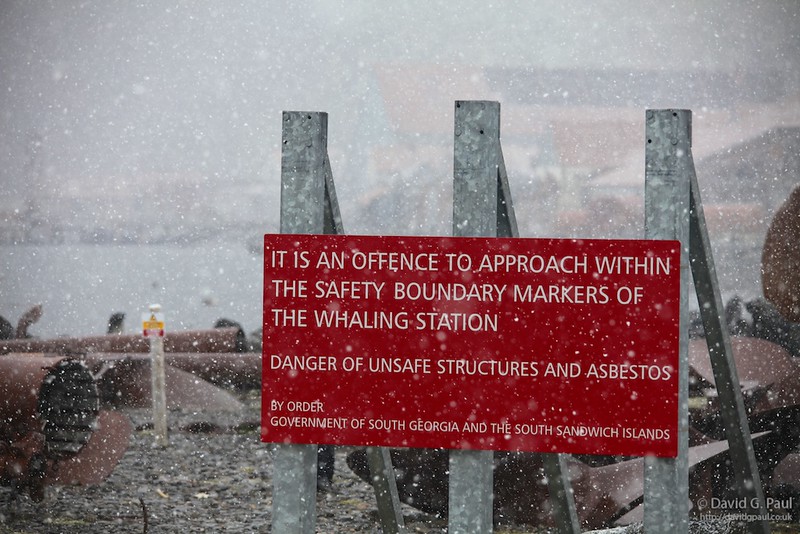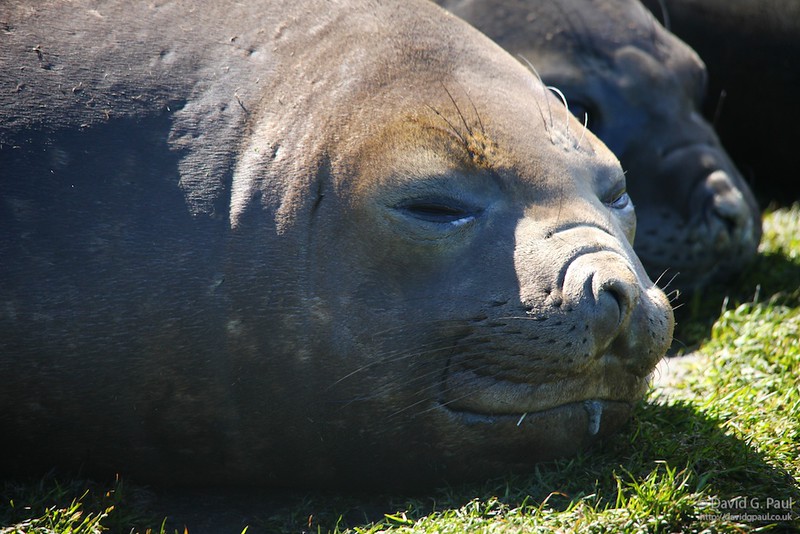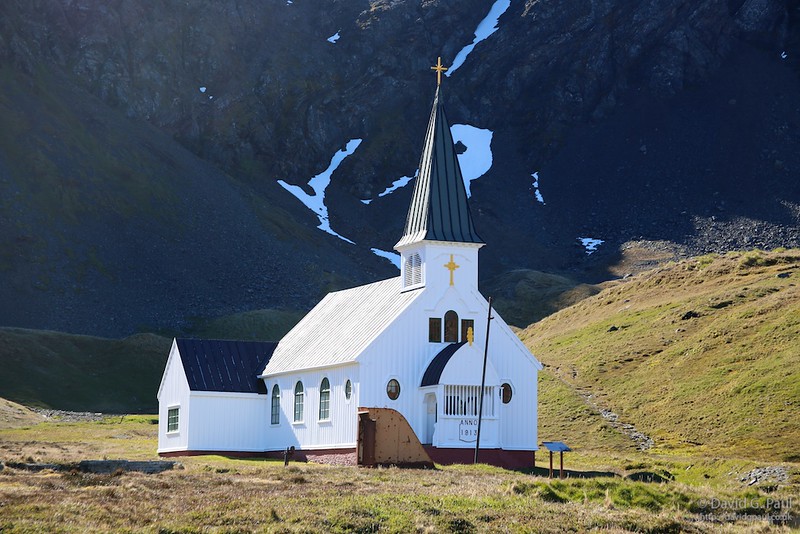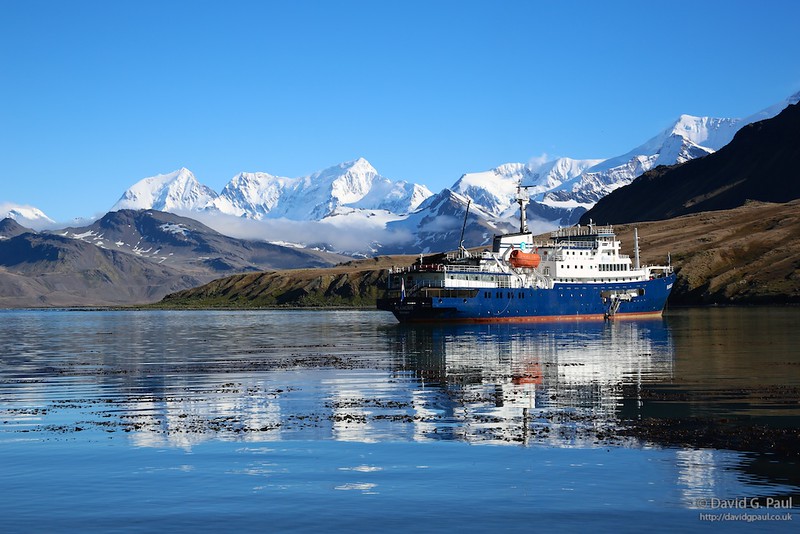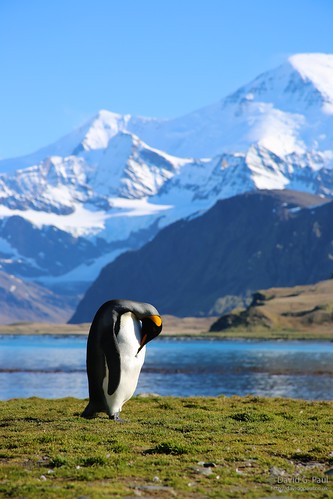Due to wanting to do the Shackleton Hike, which we were told was around 5 kilometres across difficult terrain, we were told there would be a 06:00 wake-up call if the weather looked good. We were lucky and awoke to some good weather which meant the hike could go ahead. For those doing the hike we would miss breakfast, but we could get some juice and a cinnamon pastry from the bar before leaving.
It seemed about 70% of the ship went on this optional hike and by the time everyone was ashore the weather had warmed up so I had to remove and loosen a couple of layers to avoid overheating. The route started at the beach in Fortuna Bay, and started to ascend quite steeply at first but once away from the mud and onto the slate like sedimentary rock it eased off, although the loose ground did make it more difficult as stones shifted underfoot.
At the first peak we stopped for a while to allow people to catch up, however at this point one of the Japanese couple collapsed on the floor and the Doctor had to be called over. From what I understood she’d hadn’t bothered to get any food from the bar and had fainted from the pace we were going at. This did delay is setting off again slightly and there were a few extra stops because of this – we paused at an area that was good for some scenic photography where there was a lake in front of glacial mountains. During this break there were chocolate bars handed out by the guides to everyone to keep us going until lunch time.
Shortly after setting off again we came across an area that was heavy with snow, and after crossing this we had another break on a precipice overlooking the sea and the route we’d be taking to it. In the distance we could see the Plancius had arrived in the bay not far from an old whaling station.
Part of the descent was again crossing snow where we zig-zagged back and forth until we got low enough for it to be safe to just slide the rest of the way. With the weight of my camera gear in my backpack it meant I was able to pick up some considerable speed sliding down the side of the mountain and it took some effort to stop me sliding too far. The effort of stopping actually sent my camera backpack tumbling down part of the mountain but was caught safely by one of the others on the expedition.
The descent continued for quite some time and eventually we were on a plateau which stretched for some distance and was cut in two by a stream that ran it’s length. At the far end of this plateau was a colony of Gentoo penguins which meant a considerable number of nests, all of which were being sat on. When we arrived some petrels were attacking the penguins to get at the eggs. You could see numerous eggs that had been cracked open on the floor, and the contents consumed – it was a shame to see but it’s the way of things in the natural world.
We continued on and eventually descended down to a river bed that led us back to a the sea at Stromness Harbour. The beach was filled with Antarctic Fur Seals, Elephant Seals, a couple of groups of King penguins, and a few Gentoo penguins wandering around. Part of the beach was fenced off due to an exclusion zone around the old whaling station. This is due to it being unsafe for people to enter as there is asbestos and loose machinery.
It had been snowing since having reached the plateau earlier and by the time we were on the beach the snow was coming down so heavily it had made photographs virtually impossible to take. After some time waiting around and avoiding approaching Fur Seals, we were picked up by zodiac boats and taken back to the ship so we could dry off and warm up before lunch.
From the room we could just see the whaling station through the fog and snow and we wondered if equipment would be able to dry off enough before the afternoon excursion. Before lunch there was a short briefing for the afternoon to explain what we’d be doing in Grytviken.
During lunch the snow stopped briefly and we could see the decks outside had been coated thickly in snow. This was when we first saw icebergs pass by, some getting pretty close. We had nothing to worry about though, they we very small and our boat, the Plancius, is an ice breaker anyway. By the time we had passed Cumberland Bay the weather had cleared and the sun had come out – it was starting to warm up quite quickly as well. This produced a stark contrasts to the cold winds and snow we’d encountered in the morning.
As we lowered the anchor in Grytviken we could see the whaling station museum, and Ernest Shackleton’s grave from our window. Before going ashore a resident of South Georgia, Sarah Lurcock (the Director of the South Georgia Heritage Trust), came across to the ship to talk about their efforts to restore the habitat of the island by removing non-native species of flora and fauna and doing their best to ensure no further ones are introduced.
Their main issue at the minute are the brown rats that were brought to the island by accident. So far they’ve been successful in eradicating them from the North and centre of the island at a combined cost of £4.5 million, but needed to raise £3 million by March 2015 in order to complete the South of the island before global warming causes the glaciers to recede too much.
At present it is the glaciers that prevent the rats from spreading back to areas that have been cleared, so glacier loss would undo their great work. They also have a problem with Reindeers, though they’ve paid Norwegian hunters to track and kill them – they expected this would only take another couple of weeks to complete.
Once ashore at Grytviken we were led up to a small cemetery with a white picket fence; the most prominent grave is that of “the boss”, Sir Ernest Shackleton – arguably one of the greatest explorers of the South polar region. Our arrival at his grave was 94 years and 2 days since his death aboard a ship in this bay. To toast to his memory we were each given a plastic cup and some Jack Daniels Whisky, which we all drank after a short speech.
I couldn’t believe some of the people on this expedition with us were actually standing on the graves of other people in order to get “a better shot”. The grave being stood on was that of a Thorvald Amundsen, a whaler who died of typhus and presumably no relation to the Norwegian polar explorer Roald Amundsen who was the first to reach the South Pole.
We then had a guided tour of the whaling station though I didn’t stick around for much of it as I wanted to take photographs. I was in earshot of the tour guide though so I got the gist of what was being said. Around the seafront there are a few shipwrecks of whaling vessels that are now incredibly rusty. The first one is the “Petrel”, which I believe to be the largest of the wrecks and came complete with a speargun mounted on the bow.
The whaling station has had a lot of the exterior walls of buildings removed when they were removing asbestos and making the site safe for visitors. This means you can see a lot of the internal workings of the station and the equipment that they used. At the rear of the station there is a small church which would have been used by residents then, and is still used today by the researchers that live on the island. This Lutheran church even allows you to go upstairs to ring the bells.
As we left the church a research vessel arrived at the adjacent research station, just as the guided tour was coming to an end. The end of the tour signalled a sudden rush for everyone to use the post office there it seemed – I went so I could buy some stamps, although it was some wait due to the queue that had formed so quickly.
Once I’d finished I headed over to the museum to have a quick look around, though I didn’t pay a great deal of attention to what was there. Although it seems like they’re proud of the history of the station I’m sure that it’s more a case of them having a record for historical purposes. Personally I think whaling is one of the many great wrongs we’ve done to wildlife in the name of profit and supposed progress and I hope it’s a lesson we can learn from.
The museum had a gift shop so I bought a wildlife field guide signed by the author, and a t-shirt depicting Shackleton’s expedition. Once done we then took a walk around to the other side of the bay to where the research station was located. The sun had gotten so warm by this point that it was more than comfortable to walk around in just a base layer, with coat removed. We had to be careful taking coats off though as in Grytviken there is the request that visitors do not put bags down on the floor.
Once we’d made our way through the station we found our path to the cross in memorial of Shackleton at King Edward Point was blocked by a couple of dozen King Penguins and seals blocking the path. With the 5 metre distance rule it meant there was no way passed so we turned back and walked to the whaling station again.
We were back on the boat at 18:15 which gave us some time to get sorted before the barbecue party that took place outside at the aft of the boat. The locals were also invited on board so that they could celebrate with us, and as it was the birthday of the bartender the drinks were on the house. It was incredibly windy at the back though so most people wore either their fleece layer, or a warm coat – though it seemed I was the only one that got by with just a t-shirt on.
As usual for this expedition the food was great, though we were a bit short on seating space outside so people used whatever they could as either a table or a seat. As the sun set we remained in the bay which meant it was promising the evening would be spent in calm waters.

